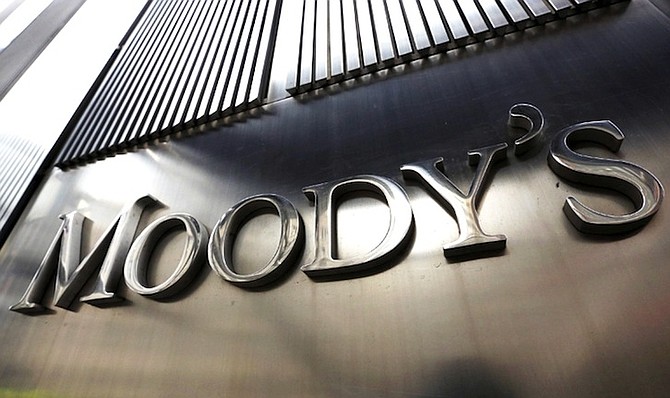By NEIL HARTNELL
Tribune Business Editor
nhartnell@tribunemedia.net
The Bahamas’ low pre-COVID economic growth coincided with bank credit to the private sector contracting by the equivalent of 20 percentage points of GDP, an international rating agency has revealed.
Moody’s, in its full annual report on The Bahamas’ sovereign released this week, said the sharp fall in bank lending as a percentage of economic output occurred during a ten-year period to 2019 when the Bahamian economy grow at a year;y average of just 1.1 percent following the 2008-2009 financial crisis.
“Credit to the private sector has been on a long-term declining trend for years, with credit to the private sector falling to around 45 percent of GDP by year-end 2019 from around 65 percent in 2010, although this figure climbed back to 58 percent in 2020,” the rating agency’s report said.
“The IMF (International Monetary Fund) attributes the contraction in credit to more stringent lending standards, a low-growth environment keeping demand for credit low and a conservative lending stance from banks. Private sector non-performing loans (NPLs) were 9.6 percent of private sector loans as of year-end 2021.”
Bank credit’s spike to 58 percent of GDP in 2020 is likely due to the economy’s near-24 percent contraction as a result of COVID-19. However, Moody’s report outlined the challenges facing The Bahamas when output returns to pre-COVID levels, which is estimated to occur at some point in 2023.
For then the country will face the same structural obstacles to growth that have remained unaddressed for decades. “The low growth rate reflects a variety of factors, including competitiveness issues, infrastructure constraints, household debt overhang resulting in low credit growth, chronically high unemployment and sluggish tourism,” Moody’s asserted.
“Structural bottlenecks have prevented The Bahamas from diversifying its economy away from tourism (which comprised over 40 percent of GDP in 2019), and include issues related to global competitiveness and high energy costs. Infrastructure bottlenecks also limit growth.
“The Government continues to pursue a number of initiatives to improve competitiveness, including the continued digitisation of public services and processes, as well as reforming the corporate insolvency regime to support improvements in the business environment,” the rating agency added.
“The Government is also actively supporting efforts to transform The Bahamas into a hub for digital assets, and has fostered a business environment conducive to the development of crypto assets. FTX, a major crpytocurrency exchange, moved its headquarters to Nassau in September 2021.”
Acknowledging The Bahamas’ vulnerability to climate-related disasters such as hurricanes, Moody’s added: “According to IMF estimates, the average annual damage of natural disasters amounted to roughly 1.5 percent of GDP (encompassing both the private and public sector) over the past 30 years. This is slightly higher than the 1.2 percent average for the Caribbean region.
“Total damage to the economy amounted to at least 5 percent of GDP for four out of eight hurricanes that hit The Bahamas since the 1990s. However, the impact of hurricanes varies greatly because The Bahamas comprises over 700 islands that are spread over more than 13,000 square kilometres, with most economic activity — and more developed infrastructure — concentrated in a few islands.
“Despite a relatively high GDP per capita in PPP (purchasing power parity) terms, insurance penetration and coverage are low in parts of The Bahamas, particularly in the southern regions, which in turn can lead to delays in reconstruction efforts (leading to growth volatility) and increased fiscal costs. Historically, the Government has responded ex-post to a natural disaster by reprioritising spending or widening the fiscal deficit, or both, which increased the debt burden.”
Noting that the Government’s increasing dependence on VAT makes the level of economic activity key to the country’s fiscal performance, Moody’s said: “The Government envisions a relatively rapid pace of fiscal consolidation, with the primary balance turning to surplus in fiscal 2022-2023 and fiscal surplus by fiscal 2024-2025.
“Based on the fiscal 2022-2023 Budget, we forecast expenditures to remain broadly unchanged in nominal terms through fiscal 2024-2025, resulting in total expenditure declining to below 22 percent of GDP. Meanwhile, the Government expects a structural increase in revenue, with the revenue-to-GDP ratio increasing to 24 percent by fiscal 2024-2025.
“The Government re-established the Revenue Enhancement Unit (REU), which it expects to help improve tax compliance, and is targeting additional revenue from changes in fees and taxes on properties that are primarily owned by foreigners or used for rental income. In addition, the Government expects several one-off sources of revenue, such as collection tax arrears, as well as potential asset sales,” Moody’s continued.
“Key risks to the Budget are overly optimistic revenue collection projections in the absence of any significant new taxes, relying instead on improved compliance and tax collection. While keeping government spending largely unchanged in nominal terms is likely achievable, particularly if capital spending is used to offset any recurrent spending overruns or revenue underperformance, the Government’s assumptions for interest expenditure imply a decline in the average cost of debt despite a rising global interest rate.”





Commenting has been disabled for this item.